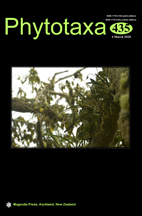Abstract
Britten (1871: 391–398), when treating the genus Kalanchoe Adanson (1763: 248) (Crassulaceae subfam. Kalanchooideae) for the Flora of Tropical Africa (FTA) project, recognised 18 species as indigenous to that part of Africa (see Oliver 1868 for the geographical coverage of the project). Six of these, 30% of the FTA kalanchoes, were based on material that Dr Friedrich [Martin Joseph] Welwitsch (5 February 1806, Maria Saal, Austria–20 October 1872, London, United Kingdom) collected while he was based in Angola (see also Figueiredo et al. 2018). In the case of four of the species, Britten (1871) explicitly linked them to Welwitsch’s manuscript names by stating “Welw. mss.” after the species names. The four species are (here and further on including the species numbers used by Britten): [#5.] K. brachyloba Welwitsch ex Britten (1871: 392); [#7.] K. platysepala Welwitsch ex Britten (1871: 393); [#13.] K. coccinea Welwitsch ex Britten (1871: 395); and [#17.] K. scapigera Welwitsch ex Britten (1871: 397). One other species, [#15.] K. velutina Welwitsch (1871: 396), was described by Welwitsch and a further species, [#10.] K. welwitschii Britten (1871: 394), was named in honour of Welwitsch by Britten, based on material collected by Welwitsch. Welwitsch also provided voucher material for the occurrence of the widespread [#4.] K. laciniata (Linnaeus 1753: 430) De Candolle (1802: tab. 100), [#11.] K. crenata (Andrews 1797: tab. 21) Haworth (1812: 109), and [#16.] K. glandulosa Hochstetter ex Richard (1847: 312) in Angola (Britten 1871).

